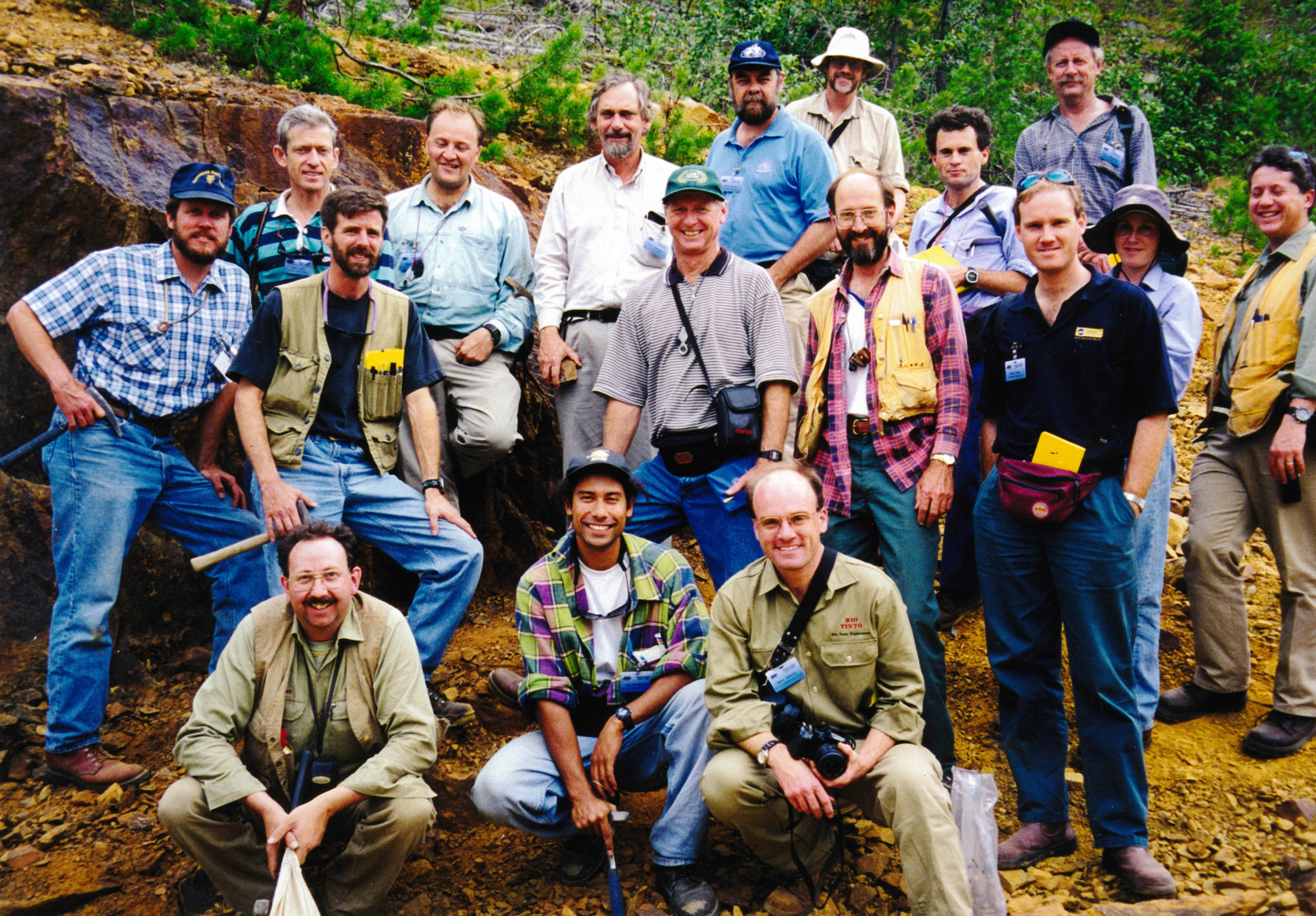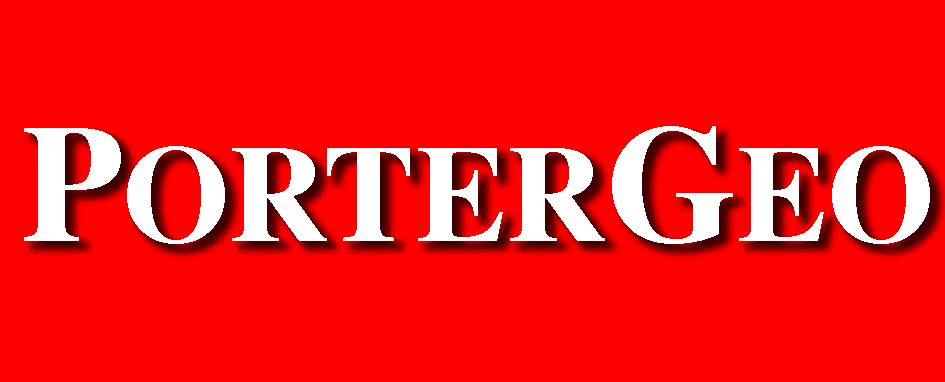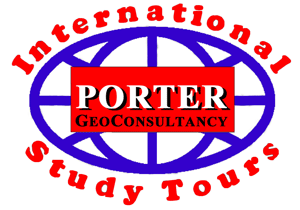| |||||||||||
| |||||||||||
| |||||||||||
|
Image: Module 2 group near Sullivan in British Columbia.

By Mike Porter
As the sound built to a crescendo, the remaining nine geologists of the AMF ZINC '98 Study Tour paused to look down into the pass below, from their vantage point high on the slopes above, where they were working.
They watched as the ungainly, box like Shorts Skyvan began to gather speed along the narrow boomerang shaped airstrip below. The scream of the twin turbines echoed from the barren scree and bare rock of the surrounding mountainsides. Towards the end of the short strip the aircraft rotated, rose briefly, touched again lightly raising a feather of dust, then finally clawed its way into the air. Once off the end of the strip, now in its own element, it gathered airspeed as it sank gracefully into the valley below, before ascending slowly, and then dwindling into the distance. As the silence of the remote site descended once more, some paused momentarily to take in the grandeur of the ragged mountains, the brilliant pink-mauve of the fireweed on the rehabilitated tracks, the softer colour of the stunted vegetation on the lower slopes, contrasting with the iridescent green of the zinc moss covering the mineralised outcrops on which they stood. Then, remembering the limited time available to them, and with some urgency, they continued to check out the outcrop, taking specimens, photos and notes. Just an hour remained before the Skyvan was to return, and then they too must depart to follow their nine colleagues who had just left. This was Howards Pass, on the Yukon-North-west Territories border in the Rockies of northern Canada, one of the greatest accumulations of zinc in the world. It was the final day of the second of three modules that made up the Australian Mineral Foundation's ZINC '98 International Study Tour. This tour would take in fifteen of the worlds greatest zinc bearing ore deposits and resources in Europe and North America. They had left Faro, some 200 km to the west that morning at 7:30 am, aboard two aircraft, each with 9 passengers. Only the Skyvan was capable of landing at, and taking off again from Howards Pass. The Beechcraft 99 proceeded direct to Tungsten, some 100 km from Howards Pass, and waited for the Skyvan to ferry its load in after dropping off the first nine. By 9:30 am all eighteen were on the ground at Howards Pass. That day they had inspected the mineralisation from the extensive underground test adit and cross-cuts, laid out in neatly labelled piles, cross-referenced to the underground assay and geological plan generously provided by the owners, Placer-Dome and US Steel. Then in the afternoon to the trenches and creek exposures of mineralisation and host sequence, before repeating the ferry and flight back to Whitehorse in the early evening. Back in Whitehorse that night, they dined and discussed geology with Rob Carnes and Gregg Jilson, names familiar to anyone who has read the key papers on the Selwyn Basin zinc deposits and the Faro/Anvil orebodies. This was also the final dinner of the module and a farewell to many of the participants. The group talked with an easy familiarity that came from travelling together for what seemed like weeks, but in fact was just nine day. In that time they had shared a unique and rewarding professional experience. They reminisced on their days together in buses and aircraft during more than 6500 km of travel. The hotels, the early morning starts and late nights, the remote and magnificent locations, the experts they had met, the technical discussions and exchanges that arose along the way. But most of all the incomparable mine visits. Now however, the module was all but over. Next day the group would fly the last leg to Vancouver and most would then disperse around the world, to their bases in Australasia, South-east Asia, Africa, Europe, North and South America. North American Sediment Hosted Deposits When they arrived in Vancouver it was full circle, back to where the module had begun. The subject of this, the second module was the sediment hosted zinc deposits of North America. It began with a one day workshop in the offices of Cominco Exploration in Vancouver. On that day, well known consultant geologist Ken Dawson and Cominco Chief Geologist Dereck Rhodes had provided a context setting session on the tectonics, geology and metallogeny of western North America, and a description of other key sediment and carbonate hosted deposits not to be seen on tour. In the afternoon four of the tour participants had made presentations on Australasian zinc deposits and discussed these with the Cominco staff present. The next day comprised an underground visit to Cominco's Sullivan mine followed by a presentation and surface traverse with expert consultant Craig Leitch to demonstrate the geological setting of the orebody. After a late afternoon and evening drive in three hire vans to Coeur d'Alene in Idaho they visited the Coeur-Galena Ag-Pb mine of Silver Valley Resources next day, followed by a geological reconnaissance of parts of the host Proterozoic Belt Supergroup. The transgressive Coeur d'Alene lodes, hosted by sediments of the same supergroup as Sullivan to the north, have produced nearly 3 and 7.6 million tonnes of contained zinc and lead respectively. From there they drove to Spokane in Washington and next day flew north to Anchorage in Alaska and then on again to Kotzebue on the coast of the Chukchi Sea, north of Bering Strait. Next morning, early, they departed in two charter Cessna Caravans for the great Red Dog mine of Cominco. It was an hours flight. On site there was a comprehensive briefing and series of lectures followed by an inspection of all of the ore types and hosts in the pit, and a reconnaissance of the un-disturbed up-dip expression of the major Aqqaluk deposit that constitutes half of the resource at Red Dog. After more discussions and a presentation by a tour participant to the Cominco staff, the group had dinner and left for Kotzebue at 8:40 pm following one of the most remarkable days of the tour. From Kotzebue they flew south to Anchorage and Juneau, then north by charter flight to Whitehorse in the Yukon of Canada. Next day, Sunday was a welcome rest day. On Monday however the routine started all over again as they took an early charter flight north to Faro to visit the Anvil Range mines. Although the operation had closed, as arranged, the receiver permitted access, and guided by Lee Pigage, now with the Yukon Geoscience Branch, but who had worked at Faro for more than 15 years, they were able to inspect the host sequence, take specimens from 'run of ore stockpiles' and study drill core through the orebodies, aided by mine plans and sections. Next day they proceeded on to Howards Pass, the last deposit on the module before returning to Whitehorse. European Deposits Soon after arriving in Vancouver, from Whitehorse at the end of the second module, the group began to say their farewells and then disperse. For some however, this was the second round of goodbyes. These were the tour members that had also taken the first module. The previous farewells had been much more relaxed in the noisy, happy, crowded pubs of the Temple Bar district in Dublin. They had started at Mulligan's, and then on Corgaran's with its Irish music and to several more whose names were later forgotten. As with the second module, the participants had travelled and worked well together, discussing what they saw and exchange ideas and experience from their various perspectives, coming as they did from companies with differing outlooks and working in various parts of the world. They had come together at the start of the tour in Lisbon on the night of Wednesday 15 July,1998 for an introductory meeting. This was followed over the next nine days by briefings from the Portuguese Geological Survey, the IGM, in Lisbon, a private enterprise overview of exploration in the Iberian Pyrite Belt from RioMin Iberica in Grandola, and visits the Neves Corvo Cu-Zn mine in southern Portugal, the Reocin zinc mine in Cantabria, northern Spain, and the Navan and Galmoy zinc mines in Ireland as well as the Lisheen project, also in Ireland. With the exception of the Iberian Pyrite Belt, this module concentrated on carbonate hosted deposits. During the module a seminar was held in conjunction with the Irish Association for Economic Geology in Dublin. This included major presentations by the internationally known experts Duncan Large and John Ashton speaking respectively on the "Zinc Metallogenesis of Western Europe", and the "Irish Carbonate Hosted Zinc-Lead Deposits". This was followed by presentations by the Irish Geological Survey and by four of the tour group on zinc deposits in Africa, Australia and India. The seminar attracted an audience of 120 from Ireland, the UK and elsewhere in Europe. This allowed the tour members access to a wide range of opinions, experience and the opportunity to network. North American Volcanic Hosted Deposits Of the group that arrived in Vancouver from Whitehorse at the end of the second module, only four continued on to the third module. These were the "long termers", those who had been with the tour since the start in Lisbon on Wednesday July 15, and would continue to the end in Green Bay, Wisconsin on Tuesday 18 August. The module would officially commence in Flin Flon, Manitoba where the "long termers" were joined by those who were to take this module alone. The module was to include visits to the mines at Flin Flon, Kidd Creek in Ontario, Bouchard Hébert (ex-Mobrun) in Quebec and Brunswick #12 in New Brunswick, all in Canada, and the Crandon Project in Wisconsin, USA. These represented deposits in Archaean, Lower and Middle Proterozoic, and Palaeozoic host volcanics. The visits would be supported by a regional geological briefing on the Flin Flon district and a surface reconnaissance with Hudson Bay Exploration and Development Co Ltd staff; a similar session with the Ontario Geological Survey in the Timmins-Kidd Creek district; an overview of the Abitibi Belt and surface traverse in the Rouyn-Noranda District with the Mines Branch of the Quebec Ministry of Natural Resources; and a regional briefing and traverse in the Bathurst area in New Brunswick with experts from the New Brunswick Natural Resources & Energy Department. In addition members of the group would make presentation to well attended local geological discussion groups in Flin Flon, Timmins and Bathurst. Organisation The mines and prospects visited were selected by the exploration managers of the four "core group" member companies that had agreed to commit geologists to the tour. These were, in alphabetic order, Normandy Mining Ltd., North Ltd, Pasminco Ltd and Rio Tinto Exploration Pty Ltd. These progressive companies, along with the others that sent geologists on the tour, demonstrated their foresight in developing staff to give them a competitive advantage by better understanding the targets for which they explore. The structure of the tour was designed for maximum impact in the minimum time. Never-the-less, the itinerary, while concentrated and compact, had essential rest days to avoid fatigue and saturation. By being split into modules, it allowed participants to select subject in which they were most interested. Some companies, notably Pasminco, exposed staff members to particular areas and deposits, by putting a different group on each module. All of the planning, costing and tedious organisational detail of the tour were carried out by the AMF. All the participants had to do was get to the starting point with their field and travel gear, and to read the preparatory literature compiled by the AMF. This literature had been delivered before-hand, along with a travel pack which included a sturdy field haversack, the detailed itinerary, air tickets, and other useful items. This preparation by the AMF permitted costs to be kept to a minimum, while removing all of the hassle and allowing the participants to focus on the main goal - some of the greatest zinc deposits in the world outside of Australia. What Next ? The planned 1999 tours include OzTour '99 visiting a selection of the major base metal and gold deposits of Australia in May, and Pacific Gold '99 going to the major gold deposits around the Pacific in September-October. Mike Porter of Porter GeoConsultancy Pty Ltd designed, organised and led this International Study Tour for the Australian Mineral Foundation. Return to TOP T M (Mike) Porter of Porter GeoConsultancy Pty Ltd. | |||||||||||











